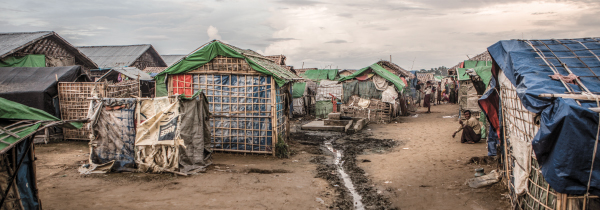 |
 |
||||||||||||||
| Discover Act Glean Cuisine Pariahs in their Homeland Speaking Up for Silence Civic U Laurels Brilliant! CreateConnectDepartments |

Pariahs in their Homeland
After Buddhist-led violence against them in 2012, more than 150,000 of Myanmar’s Rohingya, an ethnic Muslim minority group, sought refuge in government-controlled camps, where they have been detained ever sinceIn May of this year, stories started to filter out into the media about boats stranded off the coast of Thailand, Malaysia, and Indonesia. The boats were mostly filled with Rohingya refugees fleeing Myanmar and nearby Bangladesh.
The United Nations has referred to the Rohingya as one of the most persecuted groups on earth. An ethnic Muslim minority, they have suffered discrimination and violence for generations, and in 2012, after three Muslims allegedly raped a Buddhist woman, their situation grew even more precarious. Riots broke out in Myanmar’s Rakhine state, with Buddhists attacking Muslims. The Mynamar government responded by setting up camps for the Rohingya. Part of the official rationale was that they needed to be protected; another was that the Rohingya were illegal immigrants. The majority of Rohingya were refused citizenship and made to live in squalor under an apartheid- like system. Many took to the sea, hoping to escape to Malaysia or Thailand. They were smuggled by trafficking gangs, who often kept them hostage and had no qualms about raping or killing them, or selling them into slavery.
Governments in the region mostly turned a blind eye to the trafficking. But when mass graves of Rohingya who had died at the hands of traffickerswere discovered in Thailand last spring, the traffickers began to fear a crackdown and abandoned their ships packed with refugees. Hundreds of desperate Rohingya were left in the open ocean, far from land and with few provisions.
I have a sense of what must have compelled these refugees to take the risks they did. In 2013, I accompanied the photographer Andrew Stanbridge on a trip to Sittwe, the capital of Rakhine state, to document the plight of the Rohingya in Myanmar. In both the camps and Aung Mingalar, Sittwe’s one remaining Rohingya neighborhood, the conditions we found were dire.
Built along coastline that frequently flooded, many camps lacked basic necessities, including food, shelter, and medical care, and the perimeters were rimmed with barbed wire and manned by armed police and military. Guards patrolled inside the camps as well. People lived in huts they constructed from tarps, rice sacks, old billboard materials, and other found objects. “The living here is very dangerous, and there’s no future,” said Aung Win, a Rohingya community leader.
Aung Mingalar’s residents, too, were trapped, as police and military stood along barbed-wire fences and prevented them from leaving. Ushered into a mosque because the Rohingya residents feared being seen talking to outsiders, we met Abu Riad, who said, “The suffering is so bad, with such intolerable situations, how can we live here? There’s no chance of it getting better.”
Although the camps and the Aung Mingalar ghetto were less than a year old at the time, there was already a feeling of permanence. Two years later, matters are only worse. More than 150,000 people have occupied the camps established by the Myanmar government, and it appears that a deliberate policy is in place to ethnically cleanse the Rohingya from the country. Human rights organizations like Fortify Rights have documented complicity among government officials in the Buddhist violence against the Rohingya, and international agencies have issued warnings of crimes against humanity, even the potential for genocide. Yet nothing is done. Instead, Western companies, among them many European and American, have poured investments into the Myanmar market.
Andrew Stanbridge returned to Myanmar in June, while the world was focused on the stranded boats full of Rohingya refugees. There he shot these portraits of Rohingya still stuck in the country, besieged by a population that refuses to recognize their right to exist.